Scottish Study of Early Learning and Childcare: ELC Leavers (Phase 2) Report - Updated 2021
Findings from the second phase of the Scottish Study of Early Learning and Childcare (SSELC), a research project established to evaluate the expansion of early learning and childcare (ELC) in Scotland.
This document is part of a collection
Parent outcomes
Economic activity
The second of the principal long-term aims of the expansion in nursery provision, as outlined in the introduction, is for an increase in parents' opportunities to be in work, training or study. The parent questionnaire collected baseline information about parents' economic activity, which will be compared with similar data once the expansion has been fully rolled out.
Parents were asked which, out of a range of economic activities, best described their situation in the past seven days. Table 11 summarises the responses to this question.
| What were you doing last week, that is the seven days ending last Sunday? | All |
|---|---|
| % | |
| Working 30 or more hours a week (including if currently on leave or sick) | 31 |
| Working fewer than 30 hours a week (including if currently on leave or sick) | 38 |
| On maternity/parental leave from an employer | 5 |
| Looking after home or family | 54 |
| Waiting to take up paid work already obtained | 1 |
| Out of work and looking for a job | 4 |
| Out of work, because of long-term sickness or disability | 2 |
| On a Government training or employment scheme | 0 |
| In full-time education (including on vacation) | 4 |
| In part-time education (including on vacation) | 2 |
| Wholly retired | 0 |
| Not in paid work for some other reason | 4 |
| Unweighted base | 1,376 |
Base: All respondents (parent survey, weighted)
*Note: respondents were able to choose more than one response. As such, percentages will not total 100%.
As can be seen, 'looking after home or family' was the option most likely to have been selected, with 54% of respondents saying they had done this in the past seven days. This likely reflects that most of the respondents to the survey were women and, as discussed in the section on childcare, the majority also had a child in nursery for no more than around 15-16 hours a week. Around two-thirds of parents were in work with 31% reporting they worked 30 or more hours a week and 38% worked less than 30 hours a week.
Many parents reported doing more than one of the activities in the last week, in particular both working and looking after the home or family. As shown in Table 12, three-in-five (61%) of those who said they were looking after the family reported that they were currently working or on a government training scheme (including on maternity leave). A third of those in full-time employment (35%) and more than half of those in part-time employment (55%) described themselves as looking after the home or family. Small proportions also combined either work or looking after the home or family with full- or part-time education.
| Those who describe themselves as looking after the home or family | ||||
|---|---|---|---|---|
| Only looking after home or family | Also in education | Also in employment | Also in both employment and education | Unweighted base |
| % | % | % | % | |
| 37 | 2 | 57 | 4 | 763 |
| Those who describe themselves as in full-time employment (30+ hours / week) | ||||
| Only in FT work | Also in education | Also looking after the family | Also both in education and looking after the family | Unweighted base |
| % | % | % | % | |
| 64 | 1 | 33 | 2 | 412 |
| Those who describe themselves as in part-time employment (< 30 hours / week) | ||||
| Only in PT work | Also in education | Also looking after the family | Also both in education and looking after the family | Unweighted base |
| % | % | % | % | |
| 42 | 2 | 51 | 4 | 510 |
Base: All respondents who reported themselves to be looking after the home or family; to be in full-time employment; and to be in part-time employment (parent survey, weighted)
Alongside asking respondents about their current economic activity, the parent questionnaire also asked respondents attitudinal questions on the relationship between childcare and their current employment situation.
All those who were currently in work or training were asked if they would work more hours if they could afford good quality childcare. Figure 26 compares responses by household income and whether the respondent lives in a one or two-parent household.
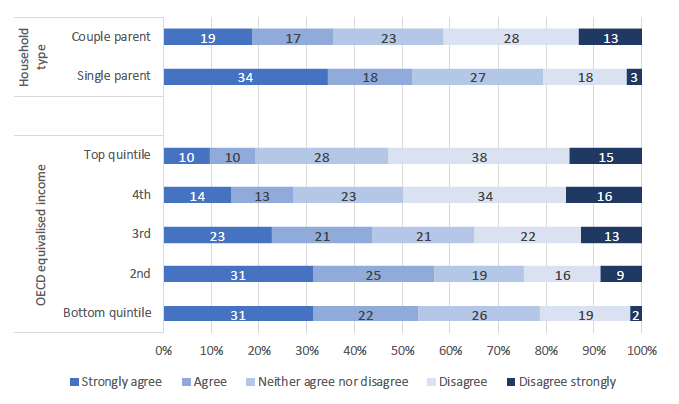
Base: All respondents in employment (parent survey, weighted)
In total, 38% of employed parents agreed they would work more hours if they could afford high quality childcare (21% strongly agree, 17% agree) with the same percentage disagreeing (27% disagree, 11% strongly disagree). Those with a lower household income were more likely to agree with the statement than those on higher incomes: 53% of those in the bottom income quintile agreed with the statement and 21% disagreed compared with 19% of those in the highest income group agreeing and 53% disagreeing. Single parents were also more likely to agree with the statement than those who were in a couple: 52% of single parents agreed with the statement and 21% disagreed compared with 36% of those in couples agreeing and 41% disagreeing.
A similar statement was presented to those who were not currently in work. They were asked how much they agreed or disagreed that "a lack of affordable, convenient, good quality childcare is one of the main reasons I'm not working at the moment". Only 28% of those not in work agreed with this statement (11% strongly agree, 17% agree), while 40% disagreed (20% disagree, 20% strongly disagree). Figure 27 shows that the pattern by income in response to this question was similar to that for the statement given to those in work. Those on lower incomes were more likely to agree that they were not working because of a lack of affordable childcare than those on higher incomes (36% of those in the lowest household income quintile agreed compared with 12% of those in the highest quintile).
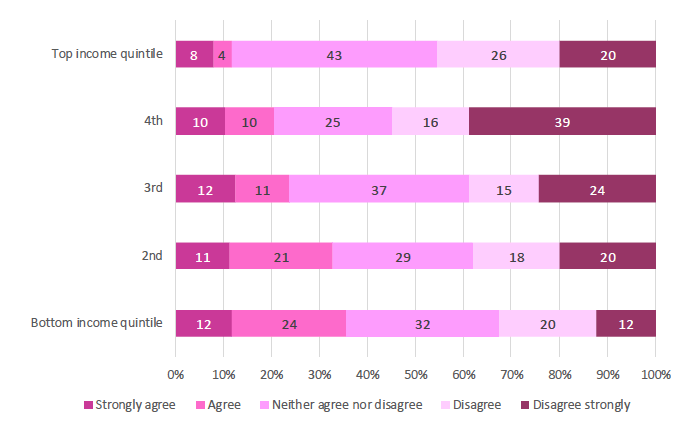
Base: All respondents not in employment (parent survey, weighted)
Parental health and wellbeing
As well as their child's health, parents were asked about their own general health. Most reported this to be good (42%) or very good (43%). Figure 28 shows that single parents tended to report worse health than those in two parent families (72% good or very good, compared with 89% of dual parents). Parents with lower levels of education also tended to report worse health (79% good or very good for those with no or only lower school qualifications, compared with 90% for those with a university degree or equivalent). There was also a general increase in self-reported good health with increasing income and with decreasing levels of area deprivation, although the patterns were not straightforwardly linear (see Tables C22 and C23 in Appendix C).
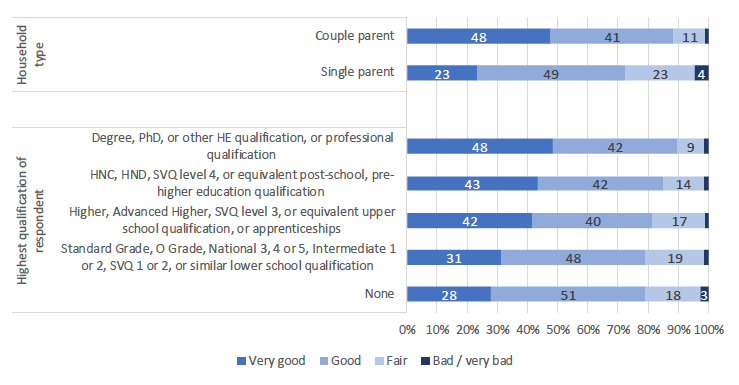
Base: All respondents (parent survey, weighted)
The survey also asked parents whether they had any physical or mental health conditions or illnesses lasting, or expected to last for 12 months or more. Eighteen percent of parents reported such a condition. This was more common among single parents than those living in two parent households (26% compared with 16%) and among those on lower incomes than those on higher incomes (25% in the lowest income quintile compared with 13-15% in the top three quintiles. See Figure 29).
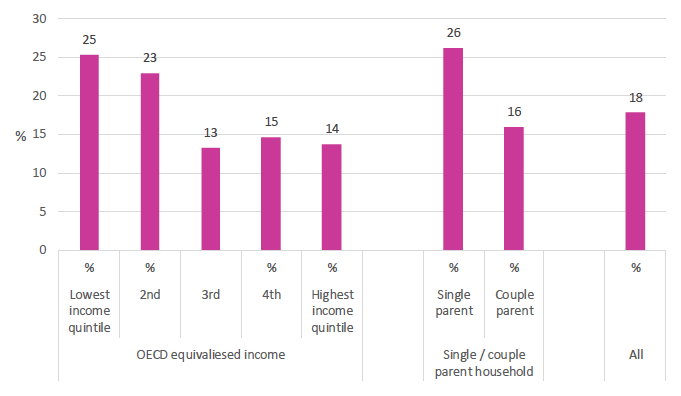
Base: All respondents (parent survey, weighted)
Parents who reported having a longstanding health condition or illness were asked whether this limited their activities in any way. Three-quarters (73%) of parents with a condition said that it did limit their activities to some extent, although only one-in-seven (14%) reported that it limited their activities a lot. Overall, 13% of all parents had a longstanding limiting health condition.
Those with a longstanding condition were also asked how it affected them (see Table 13). Three-fifths (61%) said it affected their mental health or exhibited as social, emotional or behavioural issues. Less commonly, the condition affected mobility (20%), stamina or breathing (19%) or learning, concentrating or remembering (17%). Seventy-one percent of parents with a long-term condition mentioned that it affected them in just one of the ways listed in Table 13, while 20% mentioned two different ways and 10% three or more. Of those with a mental health or social, emotional or behavioural condition, 36% mentioned additional issues.
| All | |
|---|---|
| % | |
| Vision | 5 |
| Hearing | 3 |
| Mobility | 20 |
| Learning, concentrating or remembering | 17 |
| Stamina or breathing difficulty | 19 |
| Mental health, social, emotional or behavioural issues | 61 |
| Other impairment(s) | 19 |
| Unweighted base | 250 |
Base: All respondents with a long-term condition (parent survey, weighted)
*Note: respondents were able to choose more than one response. As such, percentages will not total 100%.
The Warwick-Edinburgh Mental Wellbeing Scale (WEMWBS) is an established survey instrument for examining differences in population mental wellbeing in adults. It is not used as a clinical assessment tool, so scores on the scale have no meaning in isolation. The parent questionnaire used the shortened form of the scale, asking seven questions about how the respondent had been feeling over the previous two weeks. Responses to the questions are combined to produce a mental wellbeing score. The average score for all parents was 24.6. Analysis considered how average scores varied amongst parents with different characteristics. As shown in Table 14, single parents had significantly lower mean levels of mental wellbeing than those in two parent households. Those in the bottom two income quintiles also had lower levels than those in the top two quintiles.
For the purposes of the analysis of ASQ and SDQ scores discussed earlier, low mental wellbeing was defined as being one standard deviation below the mean – i.e. a score of below 20.5, with the mean score on the scale being 24.6. This has no clinical significance, but is useful for making comparisons between sub-groups.
| Mean SWEMWBS score | Confidence interval | Unweighted base | |
|---|---|---|---|
| All parents | 24.6 | (24.3 - 24.9) | 1,357 |
| Household type | |||
| Single parent | 23.7 | (22.9 - 24.4) | 269 |
| Two parent | 24.9 | (24.6 - 25.1) | 1,080 |
| Equivalised household income | |||
| Bottom income quintile | 24.2 | (23.4 - 25.0) | 274 |
| 2nd | 23.6 | (23.0 - 24.2) | 286 |
| 3rd | 24.7 | (24.1 - 25.3) | 247 |
| 4th | 25.3 | (24.6 - 25.9) | 264 |
| Top income quintile | 25.4 | (24.8 - 26.0) | 169 |
Base: All respondents (parent survey, weighted)
As a separate measure of parental wellbeing, respondents were asked, on a scale of 0 to 10, with 0 being very dissatisfied and 10 very satisfied, how satisfied they were with their life as a whole nowadays. The majority of parents reported high life satisfaction with more than a third (37%) of parents responding with 9 or 10 and a further third (30%) choosing 8. Only 8% gave a response of 5 or below.
As with the previous measure, household type and household income were significantly associated with life satisfaction. Figure 30 shows that single parents were more likely to be dissatisfied with their life than couple parents (19% rating it as 0 to 5 compared with 6%). Conversely, they were less likely to be highly satisfied with their life (22% rating it 9 or 10, compared with 40% of couple parents). Dissatisfaction fell with increasing income - 15% of those in the lowest income group rated their life satisfaction between 0 and 5 compared with less than 1% of those in the highest income bracket.
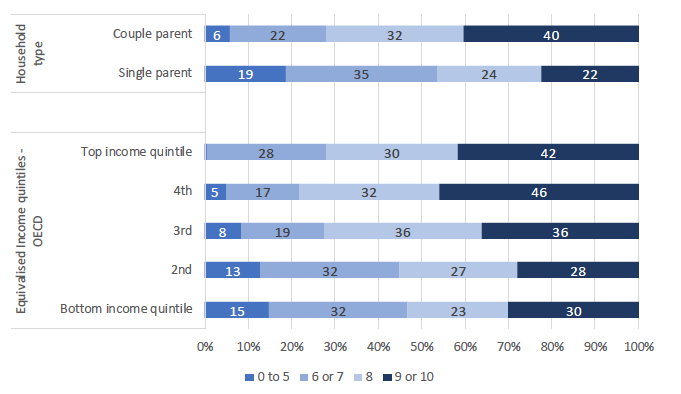
Base: All respondents (parent survey, weighted)
As a measure of parenting self-efficacy, parents were asked to choose a response from the following statements describing how they felt they were coping as a parent:
- I always feel I am coping really well - things never get on top of me;
- Most of the time I feel I am coping pretty well;
- Sometimes I feel I am coping but sometimes things get on top of me;
- Most of the time I feel I am not coping very well;
- I feel I am not coping at all these days.
Three-quarters of parents (75%) said that they were coping well most of the time or all of the time, with only 1% disclosing that they were not coping well for much or any of the time. As shown in Figure 31, confidence in parenting rose with increasing levels of education - 54% of those with no formal qualifications reported they coped well all or most of the time compared with 80% of those with a degree or equivalent qualification. The proportion of parents reporting they coped well also increased with income - from 65-68% of those in the bottom two income groups to 84% of those in the highest group – and parents in couple households were more likely than single parents to report that they coped well most or all of the time (77%) (65%).
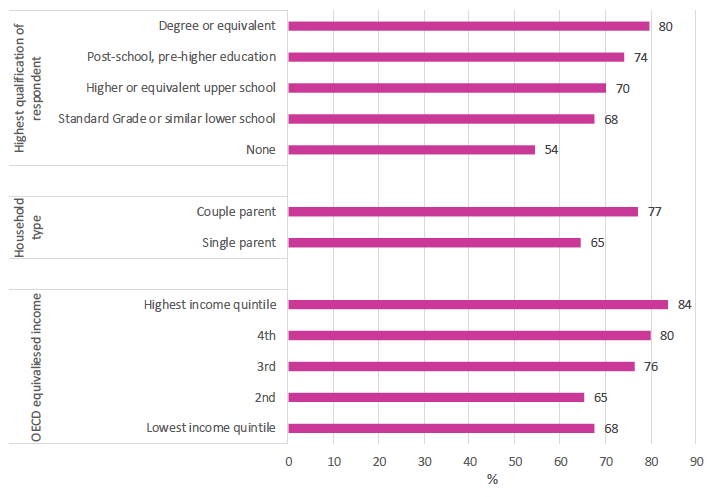
Base: All respondents (parent survey, weighted)
An important aspect of the study is to identify how having a child in nursery impacts upon parents, through the time it frees up for other activities and how it affects their wellbeing. Parents were asked how much they agreed or disagreed that because their child was in nursery they had participated in particular activities or experienced certain feelings. A summary of the responses to these questions is provided in Figure 32.
The majority of parents said that they had been able to work or look for work (59%), and that they had been able to think about what they might do in the future (54%). A quarter (27%) said that they had been able to increase the number of hours they work while around half (48%) said they had more time to themselves. A third (32%) had used the time freed up by having their child in nursery to study or improve work related skills while a slightly larger proportion (39%) had used the time to care for other family members. A much smaller proportion (12%) had used it to undertake voluntary work. Just over a third agreed that they were feeling less stressed because their child was in nursery (38%) and that they were feeling happier (35%).
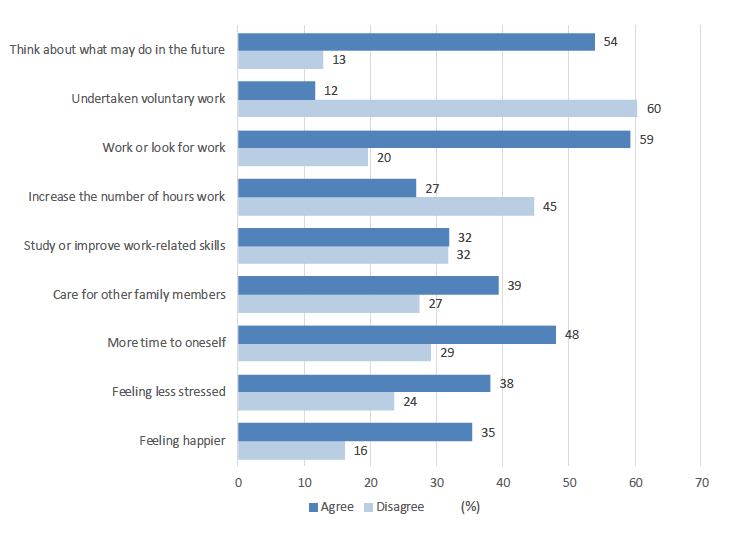
Base: All respondents (parent survey, weighted)
Throughout this section, the data has shown that single parents tend to be in less advantaged circumstances and have poorer physcial and mental health outcomes than parents in couple families. Additionally, a greater proportion of single parents indicate they would like to work more hours if they could afford childcare. Table 15 shows that where nursery care is provided for their children, a greater proportion of single parents than couple parents have been able to study or improve their work-related skills as a result (39% compared with 30%). Furthermore, a greater proportion of single parents than couple parents also reported having been able to think about what they may do in the future (65% compared with 51%). Reporting having been able to think about what they may do in the future was also more common amongst parents living in more deprived areas - 66% of those living in the most deprived areas gave this response compared with 41% in the least deprived areas. Other differences in Table 15 are not statistically significant.
| Think what may do in future | Feeling less stressed | Able to look for work | Study/ train | Base: All respondents* (parent survey) | |
|---|---|---|---|---|---|
| Household type | |||||
| Single parent | 65 | 41 | 54 | 39 | 261 |
| Couple household | 50 | 37 | 60 | 30 | 1,036 |
| Area deprivation (SIMD) | |||||
| Most deprived 20% | 66 | 42 | 54 | 35 | 395 |
| 2nd | 56 | 40 | 61 | 28 | 239 |
| 3rd | 59 | 34 | 64 | 34 | 208 |
| 4th | 48 | 37 | 65 | 34 | 219 |
| Least deprived 20% | 41 | 37 | 54 | 29 | 237 |
*Note: Base is for "Feeling less stressed". Bases for other questions may vary slightly.
Contact
Email: socialresearch@gov.scot
There is a problem
Thanks for your feedback